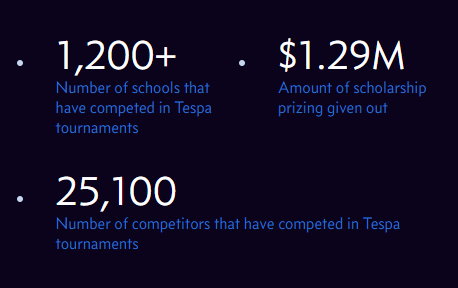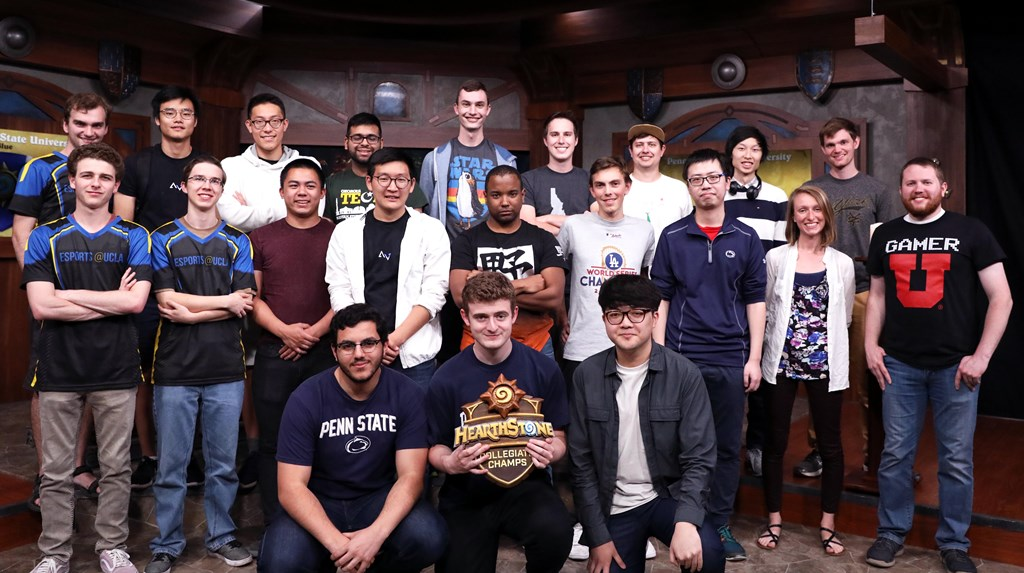
Over the weekend, college students from around North America gathered in California for Tespa’s Hearthstone Collegiate Championship (HCC) to compete for over $150,000 in scholarships to their respective universities.
For those unaware with Tespa’s work in the collegiate esports space, the company is the gold standard for event management, creating a network support system for universities and helping grow a relatively untapped market until recently.
The Tespa Impact
Founded in 2010 by Adam and Tyler Rosen at the University of Texas, Tespa rapidly expanded and formed a partnership with Blizzard Entertainment in 2014 to host collegiate tournaments in games ranging from Overwatch to Hearthstone to Rocket League and more.
Hearthstone is Tespa’s first game that they’ve been creating long-form tournaments for and it has only been growing since inception.
“2014 or 2015 was our first national Hearthstone competition and we had thousands of players from around the nation signing up,” said Adam Rosen.
“We saw so much interest that, obviously, we’ve continued it because there’s so much interest from the player and viewer perspective.”
Initially, Hearthstone tournaments at the collegiate level weren’t broadcasted as they were intended for students to build communities within their own schools and others across the country while offering compelling competition as well. Overtime, as the scene grew, Tespa felt the need to increase the production value and bring the events to a viewer’s home by broadcasting them.
Although the game itself has been around since 2014, moderately old in today’s age of ever-evolving technology within the gaming industry, Rosen has seen a steady increase in terms of interest at the collegiate level to participate in tournaments.
“This year in our competition we introduced for the first time in any of our leagues, a division for varsity teams where teams that received scholarships from their universities and are officially recognized," said Rosen.
“What we’ve found is that a lot of these teams are starting to pop up. If we look back at this same time a year ago, there were maybe one or two of these Hearthstone teams and this year we had 20. We’ve received interest from multiple universities coming to us wanting to create programs and become involved.”
As for why Hearthstone of all games has worked so well, Rosen has a few theories.
“The thing about Hearthstone that makes it so interesting is that it’s so accessible,” said Rosen, “It can be played on a tablet, your phone or computer so, basically, anywhere that people are, students especially.”
An additional aspect that is touched upon by Rosen is the level of social interaction that comes with the game itself. Being able to sit down and play with a friend on your device who is across campus, country or library enables social circles to form quickly that is not there with other esports.

Blizzard’s decision to dedicate resources to enhancing the spectating experience while watching tournaments on Twitch also creates an environment where you can learn from mistakes, understand what’s going on within the game itself and create strategies based off opponent’s play.
Creating a foundation
Blizzard’s esports approach to Hearthstone is broken down into three pillars: the Hearthstone Championship Tour (HCT), the Global Games and the collegiate level. All of them are looked at differently from a strategic standpoint and have motivations that may contrast one another.
While their goal as a company is to create revenue to continue to fuel their gaming empire, Che Chou, the Global Franchise Lead for Hearthstone Esports, sees the collegiate Hearthstone scene as less about money and more about reaching gamers early.

“For us, it’s more about establishing this network of enthusiasts that, after they graduate college, they are sort of your alumni of Tespa,” said Chou. “Creating that bedrock for the passionate gamer for our franchise is super important and for Hearthstone especially, given how open it is.”
Through the collegiate esports experience, upon graduation, many individuals who have been involved with the Hearthstone Tespa programs have gone onto playing in the HCT, stayed involved in the esports scene and gone onto having careers within the video game industry due to their involvement.
“It’s less about the glory of the prize pool or the viewership numbers as it is a strategy for Blizzard which is, we want to create lifelong fans and we want to get there during college years to cement that,” said Chou.
Interestingly enough, Blizzard has not only build a grassroots foundation for individuals to become associated with their franchise, but they also use the collegiate level to acquire Hearthstone casting talent.
Team Element
Not unique to the world of esports is the ability for numerous individuals to be able to compete alongside one another. The vast majority of those games are multiplayer games where that’s required. Hearthstone, a single player game where only two people maximum can actually play at a time, has recently experimented with the team format, including this year’s HCC.

“Overall, I think team formats was one of the big successes to come out of collegiate,” said Chou. “We ran a slightly different format for Global Games last year which was four players on a team so it was interesting to see those and we saw the three player dynamic play out well in the Collegiate Spring Championship.
The current HCC pits teams of three against one another where all players get the opportunity to play and a great deal of strategy is involved, including which players pilots which class.
“On a more tangible note and in terms of actual gameplay, what we see from team-based competitions is, at some point, a higher level of skill than we’d normally see from these players," Rosen explained. "Once we put these players together we see that they adopt tools that would need time or expertise to develop otherwise.”
A player who is more gameplay-oriented may be able to help a teammate whose strengths lie more towards deckbuilding, so within that team dynamic, the individual abilities of the parts can make up a strong whole.
Is the future global expansion?
One factor that makes the collegiate esports experience so effective in North America, compared to that of other regions around the world, is the ability for fans and communities to rally around a specific school or organization. Through Chou’s hands on work with attempting to expand Hearthstone’s collegiate scene across the world, he’s noticed a fundamental roadblock that has prevented progress.
“We found that collegiate identities in Europe are less prominent than they are in North America,” said Chou. “In Europe, it is more about country identity and national identity opposed to school identity.”
While Blizzard admitted that their short-term focus is within the North American market as they feel it still has untapped potential, Rosen has experienced a great deal of success abroad at the collegiate level.

“In 2016 we had a competition where we took the top four universities for Hearthstone, flew them to China and pitted them against the top four most prestigious universities in China,” said Rosen, “There was a ton of interest, national pride and university pride which was pretty awesome and exciting.”
As far as what Hearthstone’s collegiate landscape may look like a few years down the road, only time will tell but global domination is not off the table.
-

Tim Rizzo is the editor and a reporter for Inven Global. He joined the company back in 2017.
Sort by:
Comments :0





